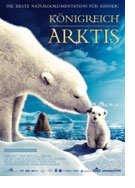

Opening 1 Nov 2007
Directed by:
Adam Ravetch
Writing credits:
Linda Woolverton, Mose Richards
Adam Ravetoh and Sara Robertson spent 15 years photographing wildlife in the arctic cold of the North Pole. From thousands of photographs, they chose those which would fit together into a coherent story which features the polar bear Nanu and Seela the walrus. Nanu and her twin brother learn to search for food in the ice. Seela grows up in a herd, under the watchful eyes of her mother and an “aunt.” Other animals, e.g., an adult male polar bear, whole herds of walruses, a polar fox, birds, whales, etc., make short appearances, but the story rests on Nanu and Seela. They grow older, immigrate to an island when summers become longer and ice rarer, suffer hunger and loss and eventually have babies of their own. They live according to the rhythm of the ice, which is melting faster than they can adjust. Without preaching, the film underlines the problems associated with global warming. The ice could be gone by 2040, which will result in extinction for animals which depend on it for home, safety, and food. This is a film which could easily provide a message in schools – even broken up into 20-minute sound-bites. In the English original, the actress Queen Lafitah provides the commentary. In the German version, three children, ages 15, 13, and 11, speak. I prefer the English version, but it is just a matter of taste. It’s more important to understand. This is from National Geographic Films, and the photography sets amazingly high standards. (Becky Tan)
National Geographic makes some of the most magnificent and powerful documentaries that have ever been filmed, and Königreich Arktis is no exception. This is a realistic, exciting and up close look at two Arctic babies, a polar bear and a walrus, who must learn to survive, not only facing nature at its hardest, but also to survive in a habitat where global warming has made a very significant impact. They do succeed and go on to secure their species for another generation, but how many generations will be able to survive in an environment that is constantly changing and therefore unknown to them?
I took my daughter Becka and her friend, Marie Christin, and they both had similar opinions about the film. What impressed them most was that the film was told from the perspective of the animals. Children narrators told the story of Nanu the polar bear baby and Seela the walrus baby in such a way as not to make light of the animal’s plight, but on a level that made them think about what all children could do to improve the animal’s situation, and both were a bit disappointed that the film didn’t include tips for children on what they would be able to do to make a change in the environment.
Königreich Arktis is breathtaking and dramatically filmed, especially the underwater photography. It isn’t just a film for older children but can be enjoyed by everyone in the family. (Tracy Moede)